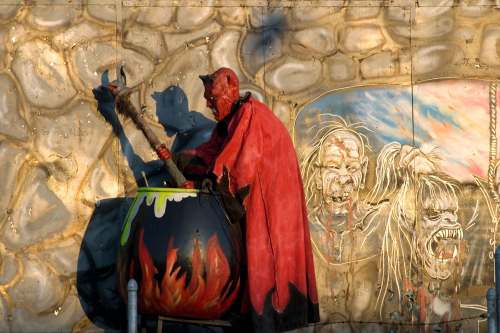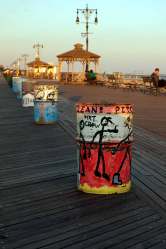 My first association with Coney Island was a copy of ‘Coney Island of the Mind’ by Lawrence Ferlinghetti my parents had brought in a fit of youthful bohemia, long since abandoned to a top shelf. I was too young to have any grasp of poetry, much less Ferlinghetti’s free verse experimentalism, but I loved the black and white cover image of the fantastic lights, spreading out for what seemed like miles. It seemed such an iconic place, embedded so deeply in the American psyche that everyone knew what it was to have a ‘Coney Island of the Mind’ (in that mid-70’s era of ‘Happy Days’, ‘American Graffiti’, everything I thought I knew about America seemed vastly more comfortable and inspiring and convivial than the spartan, parochial backwoods Canada where we lived.
My first association with Coney Island was a copy of ‘Coney Island of the Mind’ by Lawrence Ferlinghetti my parents had brought in a fit of youthful bohemia, long since abandoned to a top shelf. I was too young to have any grasp of poetry, much less Ferlinghetti’s free verse experimentalism, but I loved the black and white cover image of the fantastic lights, spreading out for what seemed like miles. It seemed such an iconic place, embedded so deeply in the American psyche that everyone knew what it was to have a ‘Coney Island of the Mind’ (in that mid-70’s era of ‘Happy Days’, ‘American Graffiti’, everything I thought I knew about America seemed vastly more comfortable and inspiring and convivial than the spartan, parochial backwoods Canada where we lived.
But when I made it out nearly two decades later, it wasn’t Ferlinghetti I thought of, but the closing act of ‘The Warriors’ which I’d seen about nine times when I lived in a group home in my teens. The decrepit subway train clattering through the last bend of the elevated, the bedraggled, exhausted gang confronting a psychotic Sean Penn rattling coke bottles in his fingers while the trash blew past the graffiti shutters outside. The station was almost derelict, and panhandlers and drug dealers lurked around the station entrance, and the street outside the carny looked disheveled, half-abandoned.
As I noted in a previous feature, I’m a sucker for abandonment and Coney Island became a regular part of my NY itinerary. Who could not love the abandoned roller coaster, half-overgrown with vines, or the vista of the elevated elongating out behind the ferris wheel, and the Cyclone, or the old-time creepiness of the carny itself (what gives carnivals this slightly sinister quality? they have have given expression to some buried pagan mysticism, the allure – and power – of the outcast, the freak. The Disney version gets rid of this hint of sleaziness and danger, this hint of the subconcious, the dream).
I liked Coney best in winter, when everything was shut down, and the boardwalk was deserted but for a few forlorn Russians out on the pier, hauling in their traps. The fog made the carny, the projects at the end of the boardwalk almost otherworldly. An old guy from the area pushed a shopping cart up and down the boardwalk selling hot latkes wrapped in tin foil. Once, not long after the collapse of communism, he said, “I’m not going to say communism was a perfect system, far from it, but the world has lost something with the disappearance of a state built around the working man.”
The carny retained a few freak shows: a sign promising a ‘man-eating chicken’, a ‘flesh-devouring rat’. I paid one dollar to a very bored looking teenager to see the rat. The two black women behind me giggled nervously, and I wasn’t sure what to expect but the killer rat turned to be an oversized hamster, half-buried in straw next to a bowl of kibble.
I did go to the stage show once. I think it cost three bucks. The audience was mostly Puerto Rican teenagers, the performers a troop of very unhappy looking white people, some with piercings and neck tattoos. One guy hammered a nail through his (pierced) tongue, another guy put on a straitjacket, and had someone from the audience tighten it up then, after some struggle, broke free. Between acts, the emcee plugged whoopee cushions – I guess they had a shipment they needed to get rid of. The kids were amused enough but the performers obviously hated their show, their audience, and wanted the whole thing to be over. The seats and the stage were hammered together with uneven lengths of plywood, the floor littered with trash; in those moments Coney Island seemed a symbol of the decay of Brooklyn itself.
But even in its decay it was surreal. A friend told me once how she’d been on the ferris wheel, and the guard dog down below, a Rotweiller or maybe a pit bull, had gotten it’s head stuck in a trash can and for the whole length of her ride she’d watched the dog thrashing about, banging the can against some nearby posts while the ride supervisor looked on, oblivious.
I didn’t go back for a long time, part of a general withdrawing from New York and the world I went through at the time. Friends told me it had become hip, with the Coney Island Museum, the Coney island Film Festival. When I did go back last year, I was shocked at how little of the old Coney remained. Gone the overgrown roller coaster, the derelict bath house, and the flesh-eating rat. Bloomberg plans to revitalize ‘the people’s playground’, but we’ll see if it will indeed be for the people or just another of the rich man developments Bloomberg seems to favor, whether the spirit of Ferlinghetti’s book cover, the Warriors, and that seedy old carney will live on.
More Coney Links:
Coney Island Freak Show in the 40’s
Classic Coney Island Movie: Little Fugitive (thanks to CO Moed)









Braddock, Pensylvania – the next Lower East Side?
Posted in Comment, Culture, Gentrification, Observations, Sunday Feature, tagged Abandoned Towns, Braddock, Lower East Side, Underground culture on March 7, 2010| 8 Comments »
Carnegie Library - Braddock PA
Perhaps. But likely not anytime soon.
I first became aware of Braddock, PA last summer, through an article in my Google news alert from the People’s Weekly World (‘We take sides – Yours! Working class opinions and views since 1924’) entitled:
‘Future for the Mons Valley: “Hell doesn’t have to last forever”‘.
At first what amazed me was not Braddock – but that an old time leftie journal like People’s Weekly World still existed in today’s America. Or today’s anywhere, since our political conversation has shifted so rightward that what would have been centrist in the 70’s is now ‘radical’ left. But then I got interested in Braddock.
Braddock, Pennsylvania, sits just outside Pittsburgh, and has a population of 2800, down from 200,000 in the 50”s. The mayor, John Fetterman, has become a celebrity of sorts. Most recently, he was profiled in the Atlantic’s ‘Brave Thinkers’ series, but many papers have profiled him from the Guardian: America’s coolest mayor? to the New York Times: Rock Bottom For Decades but Showing Signs of Life. Fetterman makes great cop: a 6’8”, 300 pound, heavily tattooed white Harvard grad with a shaved head who wants to revive a dying steel town where the remaining population is mostly black. He seems a dedicated man, has built a website dedicated to the town braddoc; ‘destruction breeds creation – create amidst destruction’ (‘braddoc’ was the local Crips’ spelling of the town’s name).
Having grown up in a town surrounded by ghost towns and abandoned mines, a town that is itself almost now completely abandoned, I’ve always been fascinated by abandonment: what it means, what places become after they’ve been abandoned. But the story of Braddock and Mayor Fetterman’s attempts to revive it, struck other chords.
Abandoned Street, Braddock PA
In an excellent article from ReadyMade Magazine( ‘One Man’s Mission to Save Braddock, Pennsylvania’), the writers illustrate not only how black people were left behind by the GI Bill, by a lack of seniority in the workplace, but how Braddock is in the absurd position of possessing the last operating steel mill in the Valley, yet how almost no one works at the mill actually lives in Braddock. As Mayor Fetterman says, “the mill’s only contribution to the community is pollution – one of the main reasons white workers, when they could, moved out.”
The mayor would like to see the white folks come back. Not the white working class – no one expects that – but the only white folks who re-inhabit depressed urban areas their parents or grandparents fled – artists, urban frontierists, chasing cheap living spaces, an off-the-grid community, freedom, or sometimes just escape.
I’ve lived in some (albeit much tamer) version of Braddock since my teens – depopulated or recently de-industrialized neighborhoods occupied by the artists and misfits Fetterman wants to attract. Since about the mid-90’s, when it became apparent that cities like New York and London would have less and less space for people on the margins, I’ve thought real artistic renewal would come from smaller centres – like grunge came from Seattle. That hasn’t happened on any meaningful level, and cities seem to be separating into two types – gentrified and depressed (or semi-abandoned). The question remains – can any kind of real cultural movement form in places like Braddock (or Detroit, Buffalo . . .). And if they can, can they revive not just the city but the fortunes of the people who already live there, or resist the uber-gentrification (a little gentrification, like a little poison, can be a good thing) that seems to follow any cultural flowering?
Abandoned Department Store, Braddock PA
The Lower East Side is a half hour’s walk from the power centres of mid-town and Wall Street – even at its most abandoned and depraved, when drug lines circled around blocks of abandoned tenements, the separation was more psychological or cultural than physical. In many respects, New York was a more egalitarian place in those days, and drugs, art, thrills, formed the nexus where the powerful and the marginal rubbed shoulders. All those spaces I inhabited (or squatted), were in the heart of the city, in properties that are in some cases now worth millions.
It takes a certain kind of person to live off the grid, and the communities that formed were often riven by drugs, conflict, or an extreme (and crippling) marginalization. Isolation, drugs, blightend landscapes, crime – these aren’t easy to take day after day, especially as you get older.
Another street - Braddock, PA
What else are communities like Braddock to do? Unless the West re-industrializes (and there seems to be a growing awareness that this might be a good idea), there isn’t much that can be done. The solution that is proposed again and again for depressed communities seems to be big box malls, gambling or a prison – Fetterman’s opponent in the last election wanted to bring in a gas station. The homesteaders provide population, new ideas, energy. Maybe, as our economy changes, the inevitability of gentrification for successful cultural communities will change as well. Maybe new industries will one day come back to Braddock . . .
In the meantime, Braddock remains an experiment worth watching. Even if it doesn’t become the next Lower East Side. And if it is successful, perhaps my little town will attract people in like fashion one day . . .
More articles:
former steeltown
From the Monthly Review: Braddock, Pennsylvania – Out of the Furnace, Into the Fire
Thread in city-data.com about Braddock, mostly from people from neighboring areas
Read Full Post »